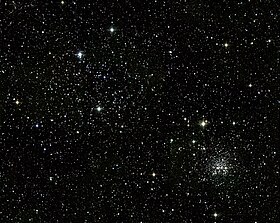
Back Messier 35 Afrikaans مسييه 35 Arabic Cúmulu abiertu M35 AST NGC 2168 Azerbaijani M35 (аб’ект Месье) Byelorussian M35 BE-X-OLD M35 Bulgarian Messier 35 BS Messier 35 Catalan NGC 2168 CE
| Messier 35 | |
|---|---|
 | |
| Observation data (J2000 epoch) | |
| Right ascension | 06h 08m 54.0s[1] |
| Declination | +24° 20′ 00″[1] |
| Distance | 2,970 ly (912 pc)[1] |
| Apparent magnitude (V) | 5.3[2] |
| Apparent dimensions (V) | 28[3] arcmins |
| Physical characteristics | |
| Mass | 1,600[4] M☉ |
| Radius | 11 ly[5] |
| Estimated age | 175 Myr[4] |
| Other designations | M35, NGC 2168,[6] Cr 82, C 0605+243 |
| Associations | |
| Constellation | Gemini |
Messier 35 or M35, also known as NGC 2168 or the Shoe-Buckle Cluster, is a relatively close open cluster of stars in the west of Gemini, at about the declination of the Sun when the latter is at June solstice.[a] It was discovered by Philippe Loys de Chéseaux around 1745 and independently discovered by John Bevis before 1750.[3] It is scattered over part of the sky almost the size of the full moon and is 2,970 light-years (912 parsecs) away.[1] The compact open cluster NGC 2158 lies directly southwest of it.
Leonard & Merritt (1989) computed the mass of M35 using a statistical technique based on proper motion velocities of its stars. The mass within the central 3.75 parsecs (12.2 ly) was found to be between 1600 and 3200 solar masses,[b] consistent with the mass of a realistic stellar population within the same radius.[7] Bouy et al. in 2015 found a mass of around 1,600 M☉ within the central 27.5' × 27.5′. There are 305 stars that can be intrinsically shown to be extremely likely to be members,[c] and up to 4,349 averaging the 50% membership probability, from the kinematic (such as parallax and proper motion) and spectral data published before 2015.[4] The cluster's metallicity is [Fe/H] = −0.21±0.10, where −1 would be ten times less metallic than the sun.[4]
Of 418 probable members, Leiner et al. in 2015 found 64 that have variable radial velocities thus are binary star systems.[8] Four probable members are chemically peculiars, while HD 41995, which in the (telescopic angular) cluster field, shows emission lines.[9] Hu et al. in 2005 found 13 variable stars in the field; at least three are suspect as cluster members. To be a member means to have a gravitational tie or, if recently freed, having been created by the same event.[10]
- ^ a b c d Cite error: The named reference
Wu2009awas invoked but never defined (see the help page). - ^ "Messier 35". SEDS Messier Catalog. Retrieved 29 April 2022.
- ^ a b Cite error: The named reference
Thompson2007was invoked but never defined (see the help page). - ^ a b c d Cite error: The named reference
Bouy2015was invoked but never defined (see the help page). - ^ Cite error: The named reference
Stoyanwas invoked but never defined (see the help page). - ^ Cite error: The named reference
SIMBADwas invoked but never defined (see the help page). - ^ Cite error: The named reference
Leonard1989was invoked but never defined (see the help page). - ^ Cite error: The named reference
Leiner2015was invoked but never defined (see the help page). - ^ Cite error: The named reference
Paunzen2014was invoked but never defined (see the help page). - ^ Cite error: The named reference
Hu2005was invoked but never defined (see the help page).
Cite error: There are <ref group=lower-alpha> tags or {{efn}} templates on this page, but the references will not show without a {{reflist|group=lower-alpha}} template or {{notelist}} template (see the help page).
© MMXXIII Rich X Search. We shall prevail. All rights reserved. Rich X Search